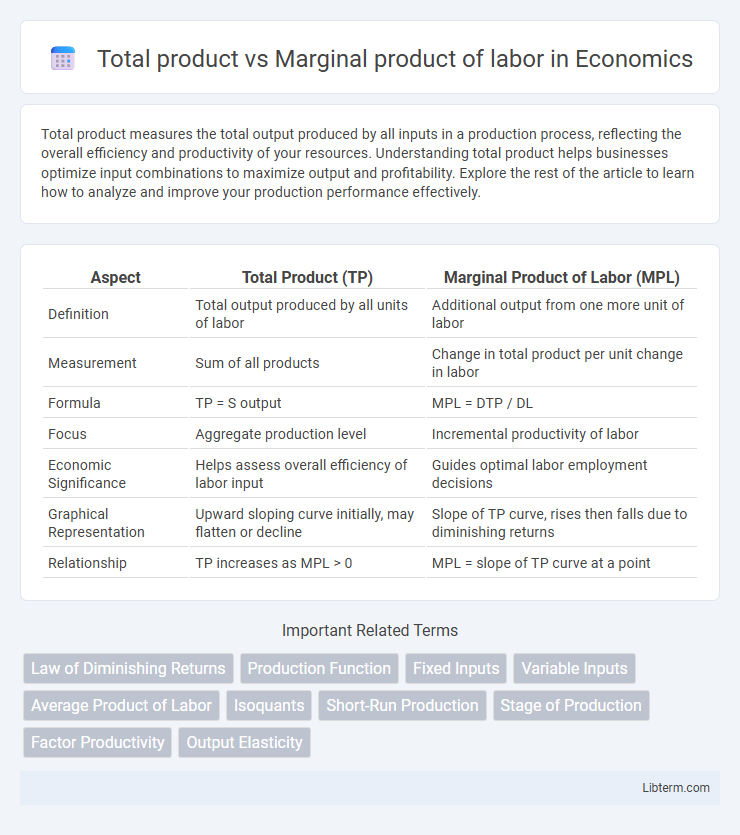Total product measures the total output produced by all inputs in a production process, reflecting the overall efficiency and productivity of your resources. Understanding total product helps businesses optimize input combinations to maximize output and profitability. Explore the rest of the article to learn how to analyze and improve your production performance effectively.
Table of Comparison
| Aspect | Total Product (TP) | Marginal Product of Labor (MPL) |
|---|---|---|
| Definition | Total output produced by all units of labor | Additional output from one more unit of labor |
| Measurement | Sum of all products | Change in total product per unit change in labor |
| Formula | TP = S output | MPL = DTP / DL |
| Focus | Aggregate production level | Incremental productivity of labor |
| Economic Significance | Helps assess overall efficiency of labor input | Guides optimal labor employment decisions |
| Graphical Representation | Upward sloping curve initially, may flatten or decline | Slope of TP curve, rises then falls due to diminishing returns |
| Relationship | TP increases as MPL > 0 | MPL = slope of TP curve at a point |
Introduction to Total Product and Marginal Product of Labor
Total product of labor refers to the overall quantity of output produced by all units of labor employed in the production process. Marginal product of labor measures the additional output generated by employing one more unit of labor while keeping other inputs constant. Understanding the relationship between total product and marginal product is crucial for optimizing labor efficiency and production decisions.
Defining Total Product (TP)
Total Product (TP) measures the total output produced by all units of labor employed in the production process. It reflects the aggregate quantity of goods or services generated, capturing the overall productivity of the workforce. TP provides a foundational metric for understanding the relationship between labor input and production efficiency.
Understanding Marginal Product of Labor (MPL)
Marginal Product of Labor (MPL) measures the additional output produced by employing one more unit of labor while keeping other inputs constant, reflecting labor productivity changes at the margin. Understanding MPL is crucial for optimizing workforce allocation, as it indicates the rate at which labor contributes to total product increase. Firms use MPL to determine the most efficient labor input, guiding decisions on hiring until MPL equals the wage rate to maximize profit.
Key Differences Between TP and MPL
Total Product (TP) measures the overall output produced by all units of labor employed, whereas Marginal Product of Labor (MPL) quantifies the additional output generated by employing one more unit of labor. TP reflects cumulative productivity and typically increases at a diminishing rate due to fixed resources, while MPL indicates the change in output and often decreases as labor input rises because of diminishing marginal returns. Understanding the distinction aids in optimizing labor deployment and maximizing production efficiency within firms.
The Law of Diminishing Marginal Returns
Total product measures the overall output produced by a given quantity of labor, while marginal product refers to the additional output generated by one more unit of labor. According to the Law of Diminishing Marginal Returns, as more labor is added to fixed capital, the marginal product of labor eventually decreases, causing total product to increase at a decreasing rate. This decline in marginal productivity highlights the inefficiencies that arise when labor input continues to grow beyond an optimal point.
Graphical Representation of TP and MPL
The graphical representation of Total Product (TP) and Marginal Product of Labor (MPL) typically shows the TP curve rising at a decreasing rate, reflecting the law of diminishing returns, while the MPL curve initially rises, reaches a peak, and then declines, intersecting the TP curve's maximum point. The MPL curve is the slope of the TP curve at any given labor input, illustrating how each additional unit of labor affects total output. When the MPL is positive and increasing, TP accelerates, and when MPL declines but remains positive, TP continues to grow but at a slower pace until it eventually plateaus or declines.
Practical Examples in Real-World Production
Total product measures the overall output produced by all workers, while marginal product of labor quantifies the additional output generated by one more worker. In a factory assembling smartphones, hiring the tenth worker might increase total production from 500 to 550 units, indicating a marginal product of 50 units for that worker. Understanding these concepts helps managers optimize labor input to maximize efficiency and control production costs in industries such as manufacturing, agriculture, and services.
Impact on Decision Making in Firms
Total product and marginal product of labor are crucial metrics for firms assessing labor efficiency and production output. Marginal product of labor informs decisions on hiring by indicating the additional output generated from one more worker, helping firms optimize workforce size to maximize profits. Understanding the relationship between total product and marginal product supports cost-effective resource allocation and production scaling in business operations.
Factors Influencing Total Product and MPL
Total product of labor measures the overall output produced by all workers, while marginal product of labor (MPL) assesses the additional output generated by one more worker. Factors influencing total product include the quantity and quality of inputs like capital and technology, as well as economies of scale and production efficiency. MPL is affected by labor specialization, diminishing returns related to fixed capital, and the level of skill or experience of the workforce.
Conclusion: Importance in Production Analysis
Total product measures the overall output generated by all units of labor, while marginal product of labor reflects the additional output from employing one more worker. Understanding the relationship between these metrics is crucial for optimizing labor allocation and maximizing production efficiency. Firms leverage this analysis to balance input costs with output gains, facilitating informed decisions on scaling workforce and resource investment.
Total product Infographic

 libterm.com
libterm.com